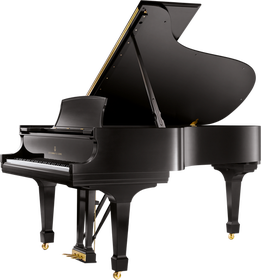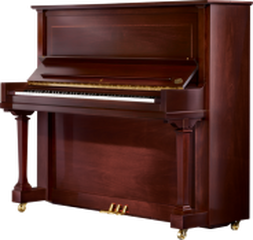Santa Fe Piano Tuner - Tim Rainwater
How often should a piano be tuned?
 That piano looks beautiful, but how does it sound?
That piano looks beautiful, but how does it sound?
I would like to give you the 'nickel speech' on piano tuning-- not the 'nickel tour'. Frequently, the story of a new customer's piano is that it has been in the family for the last one hundred years, or the piano has not been tuned for 10 or more years. My job is to help you understand why you need my tuning or repair service. I have been working with pianos for over 25 years and do it for the love of the instrument. Pianos run deep in my family, as you will see in my "Tim the Tuner" page.
I use two analogies for pianos: cars and golf. Tuning a piano is like changing the oil in a car. Clearly, there are many other services that can or need to be performed on cars. Pianos are the same way. The action (the mechanical part of a piano) has many adjustment choices to make the touch of your piano just right for you. This can involve many hours of work. As for my golf analogy, I have putts, par 3's, 4's and 5's. A short putt would be like a concert tuning, a 'hole in one', if you will. The tuning is solid and precise, because of the frequency of the tunings. A concert tuning take about 45-60 minutes. Stage and concert pianos are usually tuned before every performance -- and even before rehearsals. This could be 20, 40, 50, or 100 times a year. A long putt, or par 3, is similar to the regular 6 month in-home tuning. I'm gonna get close to the cup, if not in the cup. It's the par 4's and 5's that I use to help customers with pianos that haven't been tuned in a while. Depending on how far we are from the green, I may not be able to get a 'hole in one' without another swing with my 'club' -- my tuning hammer. This could mean extra tuning work, which we will discuss as I assess your piano. We will communicate clearly about what work may need to be done, and you will know all fees and prices ahead of time. The average home piano needs to be tuned twice a year. Many are tuned 4 or more times per year. The bottom line is, the more often you tune your piano, the better each tuning will be.
I use two analogies for pianos: cars and golf. Tuning a piano is like changing the oil in a car. Clearly, there are many other services that can or need to be performed on cars. Pianos are the same way. The action (the mechanical part of a piano) has many adjustment choices to make the touch of your piano just right for you. This can involve many hours of work. As for my golf analogy, I have putts, par 3's, 4's and 5's. A short putt would be like a concert tuning, a 'hole in one', if you will. The tuning is solid and precise, because of the frequency of the tunings. A concert tuning take about 45-60 minutes. Stage and concert pianos are usually tuned before every performance -- and even before rehearsals. This could be 20, 40, 50, or 100 times a year. A long putt, or par 3, is similar to the regular 6 month in-home tuning. I'm gonna get close to the cup, if not in the cup. It's the par 4's and 5's that I use to help customers with pianos that haven't been tuned in a while. Depending on how far we are from the green, I may not be able to get a 'hole in one' without another swing with my 'club' -- my tuning hammer. This could mean extra tuning work, which we will discuss as I assess your piano. We will communicate clearly about what work may need to be done, and you will know all fees and prices ahead of time. The average home piano needs to be tuned twice a year. Many are tuned 4 or more times per year. The bottom line is, the more often you tune your piano, the better each tuning will be.
Piano Tuning and Maintenance in Santa Fe, New Mexico
 Piano tuning is affected by humidity.
Piano tuning is affected by humidity.
As a New Mexico piano tuner, I try to discuss with new customers out states big changes in humidity. When you've got the windows open enjoying the New Mexico monsoon rains, or the evaporative (a.k.a. swamp) cooler is going, humidity can soar. Using a swamp cooler doesn't mean you automatically have high humidity, it just adds 20-30% humidity to what the outside humidity is. If exterior humidity levels are at 15%, then indoors would likely be around 35-45%. New Mexico is typically on the dry side, but we still have lots of change throughout the year. Pianos, being partially made of wood, are greatly affected by these changes, just like the sticky doors that come and go with the change in seasons.. Your piano soundboard swells up with increased humidity and flattens back out with any decrease. This will noticeably impact the instrument's tuning. I've seen indoor humidity range from 15-78%. Wood is like a sponge, quick to absorb and slow to dry out. This excessive change can ultimately crack the soundboard and other wood parts. With the humidity change, the action also changes, which then alters the touch of the piano. When regulating the action on a piano, measurements in the thousandths of an inch are dealt with, so it doesn't take much to throw off a tuning or action regulation. The only way to be sure a piano is properly maintained is to control humidity. I am a strong supporter of the Dampp Chaser system for humidity control. I've had one installed on my personal grand piano for over 10 years, and have only seen positive results. When customers have installed the Dampp Chaser system, I can always hear the benefit in their tuning stability.
Tim is the only technician I have allowed near my Baldwin grand. The work he did to prepare it for recording my album in 2009 made a huge improvement in the sound, giving me much more control over the final result. - Kirk S.
